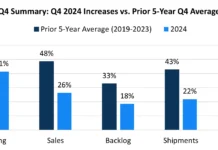By Chris Kuehl, managing director, Armada Corporate Intelligence
Not that manufacturing has avoided talking about international issues in the past, but there have been new developments that have been pushing these issues to the forefront – especially for the plastics industry. There is an old adage that asserts, “When elephants fight it is the mice that suffer.” The US and China are on a collision course, and this will have major implications for the global economy and the manufacturing community in the US (as well as Europe, Japan and elsewhere).
In a recent speech, the head of the European Central Bank (Cristine Lagarde) stated that the increased tension and hostility between the US and China could mean an increase in global inflation of over 5%. For over 40 years, the Chinese have been building capacity to become the “manufacturers of the world.” The US still accounts for the lion’s share of global manufacturing value as it produces very large and expensive items (aircraft, mining equipment, railroad engines, construction equipment and so on). China mostly produces consumer goods and parts that often go into the expensive machines the US manufactures.
The supply chain has come to revolve around the Chinese over the last few decades. Separating from this connection will be very expensive and complex.
Material dependency
In the last few weeks, the Biden administration has declared its intentions regarding the electric car market with a very ambitious plan based on making gasoline- and diesel-powered vehicles much more difficult to produce. The fuel efficiency standards will be very stringent; the idea is that carmakers will have to focus on electrics. There are many challenges involved but perhaps the most complex will be dealing with China. There are at least 14 materials necessary to produce electric vehicles and, with batteries produced almost solely in China, the US is utterly dependent on them.
In the last five years, the Chinese have imposed more than 33,000 export restrictions affecting materials the US imports. These do not ban the export of the material, but the restrictions considerably add to the cost of the goods and commodities in question. This is just one area affected by a breakdown in a supply chain that has been developing for decades.
China is the world’s largest producer of plastics – moving from a 26% share of global production to 31% since 2014. The global plastics market is expected to exceed $750 billion by 2028, and China is expected to account for at least one third of that. The trends in China’s export strategy are a concern. If there is a desire to either reduce the levels of exports to the US or a move to make these exports more costly, it will reverberate in both a positive and negative direction.
For producers of plastics, it will mean a reduced level of competition as politics interfere with China’s ability to supply demand. On the other hand, the consumers of that plastic will have to deal with higher prices and shortages that may be as politically motivated as they are economical.
Sourcing difficulties
How does the US manufacturer avoid becoming the mouse that gets trampled by this fight between elephants? The simple assertion is that the US has to find alternative sources for the materials and commodities that have been provided by China. This may be simply stated; however, accomplishing this will be anything but simple.
The US has access to its rare earth deposits but extracting these can be environmentally destructive and frequently involves massive strip-mining activity. The processing of these materials brings another risk. China has chosen to ignore these risks and the destruction, but it is unlikely the US will be able to. Other nations have the needed materials but lack the infrastructure. There are over 75 ports in China that can handle the largest of the container ships in use today. There only are 23 of these in the rest of Asia.
Vietnam received a great deal of attention in the wake of the pandemic supply chain breakdown, but production now is falling off as the country lacks the power generation needed. There is intense interest in the reshoring and near-shoring solution, but there are immense barriers, including an acute labor shortage that makes it hard to welcome in new operations seeking manpower.
Given the importance of natural gas in the production of plastics, the current position on the development of the fossil fuel sector will have an immediate impact. If the US is going to replace the Chinese output with domestic sources, there will have to be a changed position on natural gas development. The alternative will be to rely on other suppliers in the Middle East and North Africa – and that brings problems, too.
Ideally, the tension between China and the US starts to ease as cooler heads prevail. A trade war between the US and China does immense damage to both economies, and there are business interests in both nations that strongly will advocate for reduced confrontation.
Unfortunately, the economic interests are drowned out by political posturing. Both the US and China seem willing to sacrifice their economic progress to making statements of respective power, and it is difficult to see what might help defuse these tensions.
Chris Kuehl is managing director of Armada Corporate Intelligence. Armada executives function as trusted strategic advisers to business executives, merging fundamental roots in corporate intelligence gathering, economic forecasting and strategy development. Armada focuses on the market forces bearing down on organizations.
More information: www.armada-intel.com





